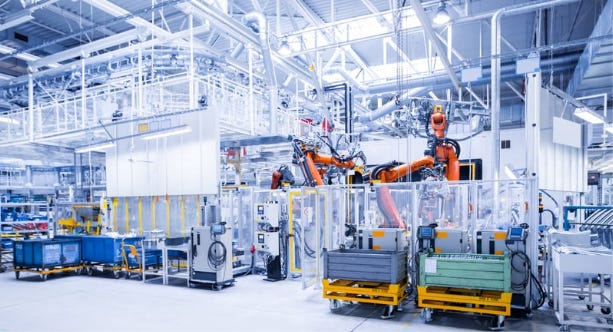The industrial sector is evolving at a rapid clip, fueled by the rise of AI and robotics, historic levels of public and private capital, and demand for more resilient supply chains. As I explored in my previous post, these forces are fundamentally reinventing how physical goods are designed, built, and delivered.
At the heart of this transformation are the visionary founders who are redefining what’s possible in an industry long resistant to change. These entrepreneurs stand out not only for their technical innovations, but also for their deep appreciation of the industry’s complexities, leveraging AI and automation to enhance—rather than replace—generations of hard-won expertise, transforming traditional processes into more agile, intelligent, and productive systems.
From digitizing tribal knowledge on factory floors to accelerating chip development with GenAI, these stories illuminate how innovation isn’t just about technology—it’s about people, expertise, and the future of industry itself. Here are five founders leading this transformation.
1. Devin Bhushan, Squint
Today’s manufacturing industry faces a critical challenge: the mass exodus of its most experienced workers. For years, factory workers have relied on veteran colleagues—who know every machine’s subtle quirks and maintenance patterns—for guidance and troubleshooting. But with Baby Boomers retiring en masse, this traditional knowledge-sharing model is crumbling. This “silver tsunami” threatens to wash away decades of invaluable expertise, potentially harming the industry’s ability to train and retain talent.
Enter Squint, a manufacturing intelligence platform founded by Devin Bhushan that’s transforming how factories preserve and transfer operational knowledge. Think of it as a digital “how-to” guide for the factory floor. With Squint, workers simply point their mobile devices at machinery to access tailored guides and procedures through augmented reality (AR). The AR overlay highlights relevant components and provides step-by-step instructions, complete with video demonstrations, troubleshooting flows, and maintenance checklists.
While AR has long promised to transform manufacturing, previous solutions like Google Glass and Microsoft HoloLens struggled to overcome the challenges associated with content creation. Squint eliminates this hurdle through AI-powered automation—workers simply record a factory floor process on video, and Squint’s AI “watches and learns” to generate detailed standard operating procedures (SOPs), preserving nuanced manufacturing expertise for future generations.
Beyond recording SOPs, Squint’s Copilot helps operators navigate unexpected scenarios and error codes in any language. Using retrieval-augmented generation (RAG), the system combines equipment manuals, contextual data (such as geolocation, camera input, and user profiles), and real-time insights to deliver expert-level guidance instantly.
“Our mission is to make every operator an expert,” Bhushan said. “In doing so, our goal is to make operations on the floor safer, faster, and better.”
Furthermore, Squint’s advanced machine vision system autonomously interprets its environment—eliminating the need for QR code systems or custom engineering—key obstacles that have long hindered AR adoption. Using deep learning algorithms, Squint can identify machinery from multiple angles and in varying lighting conditions, ensuring reliable performance even in challenging factory settings. The app also works on any smartphone or tablet, making it accessible and easy to deploy.
Bhushan’s core product philosophy centers on “building with empathy” or developing products with customer needs at the forefront. Having spent years working on products at Yahoo and Splunk, he is intimately familiar with how even the smallest design decisions might impact a user’s workflow.
“You might think it's trivial to add a ‘confirm’ button to a factory worker’s process,” Bhushan explains, “But the reality is, these workers might be standing in 120-degree heat, in humid conditions, and every time they have to touch a button, they have to remove their gloves, which could set them behind schedule. You really have to put yourself in that setting to make the right product decision.”
Since launching in 2022, Squint has partnered with leading companies such as Michelin, Nestlé, Schneider Electric, and Colgate-Palmolive. Notably, Colgate-Palmolive achieved a 50% reduction in procedure completion time among both new and experienced workers. Other reported benefits include reduced job training times, improved accuracy, and higher employee accountability.
“People are proactively looking for solutions to help them grow faster,” Bhushan said. “In the past two years, GenAI has become such a reality in the manufacturing world… We regularly get inbound requests to be part of new lighthouse facilities or state-of-the-art production lines.”
As manufacturing continues its technological evolution, Squint's approach to preserving and transferring knowledge points to a future where expertise isn't lost with retirement—it's enhanced and perpetuated through intelligent digital solutions that understand the factory floor. In Bhushan's words, they're "building the fastest way to get the right information at the right time"—eliminating the digital commute and putting expertise directly in the hands of those who need it most.
Follow Devin on LinkedIn and X
2. Pedro Pachuca, Advex AI
In factories worldwide, the promise of AI-powered automation often hits an unexpected roadblock—data collection. Despite having cutting-edge robotics and AI capabilities at their disposal, modern manufacturing teams often face a frustrating reality: they need thousands of sample images to automate basic tasks like defect detection or quality control, but collecting this data can take years.
This fundamental challenge caught the attention of Pedro Pachuca, a serial entrepreneur who witnessed these challenges firsthand while building hardware and software companies. After speaking with more than 300 manufacturers worldwide, Pachuca realized that only the highest-volume manufacturers could afford to invest in automation and data collection, given the long time horizons associated with realizing ROI.
“Today, companies typically spend six months minimum —more often one to three years —collecting the data they need,” explained Pachuca, Founder and CEO of Advex AI. “They go to management and say, 'I think I can automate this, I need $50M, and it will make us $500M —but it will take five years.' That's not a good investment.”
Pachuca’s path to founding Advex began at an impressively young age. At just 13, he built his first iPhone app, and spent his teenage years launching multiple ventures including a custom computer-building business, a photography marketplace, and a mental health startup. As an undergraduate at UC-Berkeley, Pachuca continued his entrepreneurial journey, launching a smart hockey helmet business that scaled to thousands of devices across North America. This experience provided crucial insights into manufacturing operations and the challenges faced by factories globally.
In 2023, Pachuca founded Advex AI, a platform that uses GenAI to transform a small number of images, sometimes as few as 10, into thousands of synthetic training samples needed to train robust automation systems. What distinguishes Advex's approach is its proprietary diffusion models. Unlike other simulation techniques that rely on physics or game engines, Advex’s platform generates new training images in seconds, without any setup. But the real innovation lies in how the system analyzes existing datasets. Their models identify gaps in a manufacturer's dataset—such as specific lighting changes, scratches, or dents—and generate those precise scenarios. This capability has proven particularly valuable for manufacturers facing pressure to maintain quality while dealing with workforce shortages.
Today, Advex partners with leading enterprises to drive operational transformation. In one example, they helped a major automaker overcome a significant data challenge for automating quality inspection of a semi-truck component. The client initially estimated they needed to collect 500 images for each defect type —but had only collected 13 images in total—a gap that would take approximately three years to close.
Using Advex’s platform, the manufacturer transformed these 13 images into a complete dataset in less than three hours. Within a month, Advex’s models achieved production-ready accuracy, reducing development resources by more than 50% and increasing sellable output by 1.5%—a significant improvement for production lines handling 30 to 100 million parts.
As manufacturers face growing pressure to increase output while dealing with persistent labor shortages, tools that can accelerate automation adoption are becoming increasingly critical. Advex's approach to solving the data bottleneck points to a future where AI automation becomes accessible to manufacturers of all sizes, not just those with the resources for years-long data collection efforts.
“Whether it's dents in metal, scratches on fabric, or discolorations on plastic, our system is repeatable and delivers clear ROI,” Pachuca said. “We’ve found a way to solve what many recognize as the hardest problem in AI—data collection—and apply it in a way that really matters.”
Follow Pedro on LinkedIn and X
3. Alex Huckstepp, Uptool
In machine shop after machine shop, Alex Huckstepp encountered the same, chaotic scene: stacks of paper quotes, endless phone calls and email threads, and overburdened owners trying to juggle customer requests while managing production. After more than a decade of building hardware-driven manufacturing startups, Huckstepp finally realized the industry’s most pressing problem—and it wasn’t about inventing new ways to make things.
“After doing four similar companies in a row that were either inventing a new process for manufacturing or building their own factories, I realized that it didn’t make a huge difference,” Huckstepp said. “The biggest opportunity is not in trying to reinvent how things are fundamentally made —it is in applying existing manufacturing processes in a much more efficient, intelligent, and productive way.”
Huckstepp, who was on his first career break in 10 years, ultimately teamed up with 3D printing veteran Benny Buller. Their conversations kept coming back to one specific area—Computer Numerical Control (CNC) machining, where pre-programmed machines precisely cut and shape materials into finished parts. The CNC market stood out given its significant size (valued at >$66B in 2023), mature technology, and its inherent digital backbone —making it an ideal platform for further innovation.
What caught the co-founders’ attention wasn’t CNC machining itself, but the businesses using it. During their extensive visits to local machine shops, they discovered a striking paradox: while business owners operated sophisticated machinery worth millions of dollars, their operations often ran on old-school on-premise software, paper forms, and phone calls—and largely in the general manager’s head.
“Imagine an old-school diner that still runs on pen and paper—it only works because one person can run the business in their head. Most machine shops are like that,” Huckstepp said. “Compare that to a Starbucks or McDonald’s—they tend to do significantly more revenue per employee. The reason is that there is a system that helps them operate. We saw an opportunity to build this system for small business manufacturers.”
Huckstepp and Buller realized that this problem was particularly acute in high-mix machine shops—businesses that produce a variety of custom parts rather than large volumes of standardized components. In these shops, owners typically spend more than half of their time handling sales quotes and responding to basic customer inquiries, according to the cofounders’ research. And in an industry where the first supplier to respond often wins the job, speed is paramount.
This insight ultimately led to the creation of Uptool, an all-in-one operating system designed specifically for small and medium-sized manufacturing businesses. The platform first aims to address the most pressing pain point for these owners: sales and marketing. Using AI, Uptool aims to automate much of the quoting process, handle routine customer inquiries, and provide a lightweight customer relationship management (CRM) and marketing automation system—thereby freeing owners to focus on more strategic tasks. Over time, Uptool plans to expand to cover the entire business operations of a machine shop, purpose-built for their customers who often lack internal IT departments or the ability to implement and maintain internal systems.
Today, Uptool is working with its first cohort of machine shops, with plans to expand its platform to serve the tens of thousands of small and medium-sized shops across the country. For Huckstepp, this represents a full-circle moment in his manufacturing career.
“For a decade, I was selling new ways of making things,” Huckstepp said. “But throughout this experience, I gained much more appreciation for existing ways of making things that have been refined over centuries. These shops are the bedrock of the industrial base.”
Follow Alex on LinkedIn, Medium, and X
4. Shelly Henry, Moore’s Lab
It’s hard to overstate the boom in American semiconductor manufacturing. By 2032, domestic capacity is expected to triple—the fastest growth rate worldwide—reversing a decade-long decline that left the U.S. lagging behind other major chip-producing regions. Driven by AI infrastructure demands, the CHIPS and Science Act, and rising national security concerns, this growth could meaningfully increase the U.S. share of global fabrication capacity from 10% to 14%.
Despite this momentum, design remains a critical bottleneck in semiconductor production. In fact, design costs skyrocketed from $30M in 2006 to $540M in 2020, with projects requiring coordination among hundreds or even thousands of engineers. This challenge caught the attention of semiconductor veteran Shelly Henry, who witnessed these challenges firsthand while at Arm and Microsoft.
“Today, building a chip can take more than a year and cost hundreds of millions of dollars,” Henry said. “My goal is to shrink the time it takes to get to market from one to one and a half years to three to four months—with costs dropping as a byproduct."
Henry’s journey to the semiconductor industry was anything but conventional. After earning a degree in naval engineering from the Indian Institute of Technology, he began his career as a shipbuilder in Germany. Later, he moved to the U.S. to pursue a master’s degree in applied mechanics at the University of Illinois at Urbana-Champaign. There, an elective course in electrical engineering sparked his passion for chip design, leading to a complete pivot in his career trajectory.
“I had to train myself to think differently—in terms of hardware, not software. When you write code, you have to think about how it will translate into a flip flop or multiplexer,” Henry said, referring to the components of a chip. “Finding problems within code is very challenging... You are dealing with nanoseconds of delays, and if it doesn’t transition at the right nanosecond, the circuit won’t work.”
Henry’s determination ultimately landed him at Arm, where he contributed to six processors in the Cortex-A series over 13 years. His subsequent role at Microsoft expanded his expertise across HoloLens, quantum computing, and AI infrastructure projects.
After nearly 20 years in the industry, Henry was ready to strike out on his own. In late 2024, Henry co-founded Moore's Lab alongside Sirish Kumar and Shashank Chaurasia, bringing decades of collective expertise from Microsoft, Tesla, Intel, and Qualcomm.
“When we all got together and built our first prototype, we were amazed,” Henry said. “Our system could take a paragraph of an architectural specification in natural language, run it through the entire process of engineering work, and produce a final output that could be used by SkyWater foundries—all in less than 30 minutes.”
Moore's Lab currently focuses on verification, a crucial step that traditionally requires months of engineering work. Their platform combines AI with electronic design automation (EDA) tools to automatically identify bugs, optimize performance, and implement fixes in real time. The system also provides users with real-time visibility into the AI’s verification process, ultimately producing foundry-ready output in just days rather than months.
Looking ahead, Moore's Lab aims to expand its automation capabilities across the entire semiconductor development process. Henry is optimistic about the potential of GenAI to further automate workflows in this space.
“We're just getting started,” Henry said. “With AI advancing rapidly and our team's determination, we're positioned to transform how the industry approaches chip design in the coming years.”
Follow Shelly on LinkedIn
5. Michael Bogomolny, Infinitform
For decades, the manufacturing industry has grappled with a persistent challenge: designing parts for production remains a largely manual and time-consuming process. While AI has revolutionized many areas of engineering, the core task of designing components for traditional manufacturing still demands weeks of effort—often leaving engineers with limited capacity to explore alternative design options.
This long-standing issue inspired Michael Bogomolny, a veteran of design and manufacturing technology, to launch Infinitform, an AI-powered platform that is reshaping how engineers approach manufacturing design. Acting as an intelligent design partner, Infinitform transforms requirements for computer-aided design (CAD) models into production-ready designs, reducing this process from weeks to mere minutes.
“Today, 99% of engineers are designing for traditional processes like CNC machining, die casting, and injection molding —not 3D printing,” Bogomolny said. “There was a missed opportunity to address design automation for traditional manufacturing, and that’s why we founded Infinitform.”
What sets Infinitform apart is its unique approach to generative design. Unlike existing solutions that are primarily optimized for 3D printing, Infinitform’s AI generates CAD-compatible designs that “look and feel” as if they were created by experienced engineers, according to their customers. The platform’s workflow is also straightforward and easy to use: users import a CAD model, interact with an AI-powered assistant to define parameters, and receive optimized, manufacture-ready designs within minutes. The system’s custom GPU solvers enable engineers to explore multiple configurations in parallel—such as 2.5-axis, 3-axis, or 5-axis CNC machines—while accounting for real-world constraints such as tool size, material properties, weight reduction targets, and cost considerations.
Bogomolny’s journey to founding Infinitform is rooted in a lifelong connection to engineering. Born to engineer parents, he later served as an engineer in the Israeli Defense Forces before earning a Ph.D. from Technion-Israel Institute of Technology. He then completed a postdoc at the Technical University of Denmark, specializing in topology optimization. After moving to the U.S., he joined Altair, a leading engineering software company, and later founded ParaMatters, a company focused on generative design for 3D printing. While ParaMatters found traction with an initial base of users and was ultimately acquired by Carbon, the software fell short of achieving the widespread adoption Bogomolny envisioned.
“At ParaMatters, we built what many considered the best topology optimization technology on the market,” Bogomolny said. “The problem was that 3D printing got stuck in this level of prototyping, with low volumes of production. Mainstream engineering wasn’t adopting it because it couldn’t compete on cost, and the process itself was much slower.”
This insight led Bogomolny to shift his focus with Infinitform to traditional manufacturing, starting with CNC machining—a market that is both more mature and orders of magnitude larger than 3D printing.
“We’re bringing scalability to the market,” Bogomolny said. “Our software empowers companies to make decisions about which design choice is most effective for their specific use case, while considering trade-offs across cost, weight, performance, and more.”
Since launching in December 2023, Infinitform has partnered with leading aerospace, defense, and automotive companies. By meaningfully reducing the design-to-manufacturing timeline from weeks to minutes, the company eliminates much of the back-and-forth between design and simulation teams and enables engineers to focus on high-level work.
“Today, engineers spend too much time detailing and drafting when they should be focusing on creativity and judgment,” Bogomolny said. “Infinitform removes these hurdles, shortens the design cycle, and provides many more options to consider.”
As manufacturing faces growing pressure to accelerate development cycles while optimizing for cost and performance, tools that can automate complex tasks are becoming essential. In Bogomolny's vision, Infinitform will define a new category of collaborative design tools, bringing intelligence and automation to the next generation of products—fundamentally transforming how engineers approach design.
Follow Michael on LinkedIn








